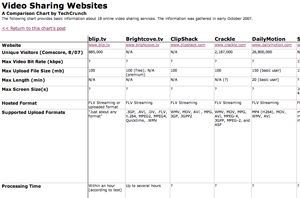
Time for another roundup, and this one coincides with a notable first-year anniversary: that of Google’s $1.65 billion acquisition of YouTube, confirmed on October 9th, 2006.
Since then, the name “YouTube” has become virtually synonymous with “online video sharing”. According to Comscore, the website maintains a sizable lead over competitors with 205,593,000 unique visitors per month. Second-place Yahoo Video trails with 48,026,000 visitors. But must YouTube remain the clear winner in the online video space? While they have certainly captured the largest audience – which may in the end be all they had needed to do to secure their position – we shouldn’t underestimate the many other companies vying for mindshare.
Even if YouTube remains the destination of choice for the vast majority of consumers, producers ought to take a serious look at the alternative services. They often support more file types, bigger uploads, and higher resolutions. They also place fewer restrictions and provide an array of features simply overlooked by YouTube. That said, a few of these services are mere YouTube clones and hope to follow in YouTube’s footsteps by providing very basic features.
These are the services we looked at: blip.tv, Brightcove.tv, ClipShack, Crackle, DailyMotion, Sony eyeVio, Google Video, Megavideo, Metacafe, Motionbox, Revver, Spike (ifilm), Stage6, Veoh, Viddler, Vimeo, Yahoo Video, and YouTube.
Since they are all about 80% the same, I’m not going to go through each of them one-by-one at length. However, there are some overall trends that ought to be pointed out, as well as some key differentiators. To get into the details as to how all of these websites differ, check out the comparison chart we’ve provided above. You’ll notice that there are some gaps, so please email me if you can help us fill in the holes.
First of all, only YouTube, DailyMotion, and Metacafe appear to place any hard restrictions on video length. With the rest, video lengths are determined indirectly by file size restrictions. While YouTube and several of these sites place the file size cap at 100mb per upload, others place it higher at 250mb, 500mb, or 2000mb. Veoh places no limitations on file size, but they recommend you use their desktop player for files over 100mb. If you’re willing to fork over some cash for a premium membership, Brightcove.tv and Motionbox will also let you upload files of any size.
While YouTube allows users to upload files only formatted as .WMV, .AVI, .MOV, or .MPG, other services accept a much greater range of file types. If you want to make your life easier, however, get into the habit of encoding in .MOV (Quicktime) and you’ll be welcome at almost all of these sites.
When it comes to video quality/resolution, it’s not perfectly clear how these services compare, because most of them don’t state their video bit rates or explain their transcoding processes. However, several of them clearly blow YouTube out of the water. Stage6, a DivX-based service, and Sony’s eyeVio, a Japanese-only service, support the most stunning video quality. Videos hosted by Veoh and Crackle also look very sharp.
Out of all these alternative services, blip.tv stands out as the most professional video sharing solution. The website and player are cleanly designed, they accept perhaps the widest range of file formats, they will automatically syndicate your videos to many other websites, and you can choose to place midroll, postroll, adjacent, and overlay advertisements in your uploads. Additionally, you can track your shows’ statistics quite closely and allow users to download your videos. I could go on and on about blip.tv’s useful features. The only major bummer with blip.tv is that you can’t seek ahead to points in a video using their Flash player.
It’s no surprise that shows like Rocketboom have decided to migrate over to blip.tv. We even decided to use them for our TechCrunch40 conference. And PC World agrees with us that blip.tv tops them all.
While we have a strong preference for blip.tv, the others have their own peculiarities that may make them more attractive to you. ClipShack, while mostly a YouTube clone, has an area where you can use a webcam to add movie, book, video game, and TV show reviews directly to the site. Crackle serves as a talent discovery system through which amateur producers can win a chance to pitch ideas to Sony and other media executives.
Dailymotion, Metacafe, and Megavideo support a wide range of languages. Sony eyeVio, which unfortunately doesn’t plan to roll out an English version, enables users to download videos straight to their PSPs, Walkmans, iPods, and mobile phones. Metacafe and Megavideo both have programs with which they pay content creators according to how many people view their videos. Motionbox, the most private of the services, has a video player with a unique filmstrip that can be used to visually locate segments in a video (they also provide a simple online video editor).
Revver provides a WordPress plugin so that video bloggers can upload and manage their content more efficiently. Veoh lets you both upload videos to other sharing sites and watch videos from all over the Web in its download client. Vimeo sports the best-designed website and a strong community feel. And Viddler’s player packs in a bunch of features, including the ability to leave comments in videos at particular points.
Since embeddable video players are the faces of these services, we have placed screenshots of them below (click to enlarge). We are also in the process of uploading a sample video to each of these websites so you can compare their video qualities. Links to these videos can be found in the comparison chart.
|
blip.tv |
Brightcove.tv |
Crackle |
|
Dailymotion |
Sony eyeVio |
Google Video |
|
Megavideo |
Metacafe |
Motionbox |
|
Revver |
Spike (ifilm) |
Stage6 |
|
Veoh |
Viddler |
Vimeo |
|
Yahoo Video |
YouTube |
















































Comment